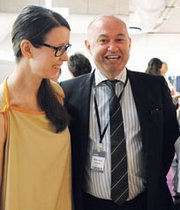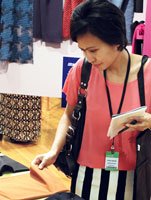Brisk Business at Premiere Vision Preview New York
NEW YORK—The aisles were crowded and the scenein many booths was standing-room only at the July 2012run of Première Vision Preview New York, held at theMetropolitan Pavilion and Altman Building in the Chelseadistrict.
"It seems like a lot more traffic than in the past," said JosetteSloss, sales director for Turkish mill Kipas Textiles & ApparelInc. "People's [travel] budgets are starting to free up."
Exhibitors at the upscale textile show included returninginternational textile mills, as well as new exhibitors and some companies returning aftertaking a hiatus for several seasons.
"For the first time we regain the[exhibitor] level of before the [U.S.economic] crisis," said PhilippePasquet, chief executive officer ofPremière Vision. "The players arenot exactly the same. The crisishad its impact. I think we are onthe right track."
One of the returning exhibitorswas French technical fabrics millSofileta, which had not shown atPremière Vision Preview in four orfive years, according to Sales ManagerTae Hwang, who is based inthe company's Los Angeles office.
"We wanted to make more contactshere on the East Coast andrefresh some of [the old contacts].The U.S. business has had its upsand downs. This year, we've had aslight increase as we restore moreof the old clients."
On the first day of the New Yorkshow, Hwang said he was seeing afew new customers but primarilyconnecting with existing accounts.
"We're seeing a mix of swim andouterwear [makers. Many are] stilltrying to fill in for Spring needs.They're not necessarily looking forFall," he said.
Longtime Première Vision Previewexhibitor Sandrine Bernard,president of the U.S. office ofFrench textile mill Solstiss, wasbusy showing the couture Frenchlace collection, as well as silk collectionDenis & Fils.
"This morning was great. It'sa very good start," she said onopening day. Bernard said she sawmany East Coast brands, as well asseveral designers and fabric buyersfor West Coast lingerie, swimwearand ready-to-wear collections.
"People are placing sample orders,"she said, adding that manycompanies are starting to bookproduction orders, as well.
"We have had nice orders forSeptember and October," she said."We started showing the collectiona month ago. Now that Prêt â Porter[in Paris] is in June, everyone isready to see the collection earlier."
Among the 2,722 attendeeswere designers and fabric buyersfrom Michael Kors, Ann Taylor, Banana Republic and Jill Stuart.Among the West Coast labelsshopping the show were BCBGMax Azria, Guess Marciano,Juicy Couture, JBrand and TrinaTurk.
U.S. buying power
Many of Première Vision Preview'sexhibitors were finding therecovering U.S. economy a goodalternative to the struggling Europeanmarket.
"That's what we're seeing—New York and L.A. are starting tomake up for [the softening of theEuropean market]," said TurkayKocasoy, export sales marketingmanager for Turkish mill CANTekstil.
"We still have consistent orders[from Europe], but the size of theorders are cut down."
Although Europe's economicmalaise is taking a toll on manytextile businesses, some companiesare faring well, according to PremièreVision's Pasquet.
"There's a big difference betweenthe market conditions inEurope. Not everywhere. It's toughin the southern part of Europe—especially Italy—also Spain andPortugal," he said.
"By comparison, the U.S. is agood market. We have to be cautiousbecause there are still questionsin the [U.S.] market about theway it will evolve in the comingmonths. There are some economicissues to be solved and some politicalissues."
Michele Vigano, owner of Italianmill Seterie Argenti SpA,agreed that the American marketis one of the strongest for his company,which exports 85 percent ofits production.
"American business is good—one of the best in the world at themoment," he said. "Europe is terrible.Brazil is a bit down, Chinais not booming. Here [in the U.S.],there's good stability. Orders aregetting a bit larger, and more companiesare importing from Italy. Weinvest a lot in our export markets."
After the U.S. economic downturn,many companies looked todiversify their business acrossseveral international markets.Première Vision operates severalother regional shows in Russia,Brazil and China in addition to itslargest, central event, Première Visionin Paris.
"The emerging markets arestill much more lively," PremièreVision's Pasquet said. "They areslower than they have been in thelast few years—China, Brazil, Russia.But they still represent a newoutlet in the fashion industry."
Pasquet said the luxury segment,in particular, is showing strength.
"Because we're positioned tothat part of the market, we are, in away, protected."
Nicolas Brun, who representsFrench textile mill AB Creationsby Fabien Doligez, said his companyis seeing increased businessfrom the United States as well asother markets around the world.
"Our American business is goingup," he said. "We're workingvery well in China and more andmore in Japan [and] Australia, aswell. The smaller markets are extinct.Strong markets get stronger,and the small markets disappear."
Diversified markets
But not every company was experiencinga downturn in Europeanbusiness. Solstiss' Bernard said shewas seeing increased business withlarge manufacturers in "Spain,Germany—everywhere."
And for German print mill KBC,the European market remains key.
"The European market is thestrongest [for us]—Spain, U.K.,Germany, France," said PeterVoegtlin, KBC sales manager. "Wedo very well here [in the U.S.],China, as well, Australia, verywell. Brazil—it's complicated todeal with."
Brazil's strong economy is intriguingto many Première Visionexhibitors, but its high duties andtaxes on imports make it a challengingmarket to enter.
"The problem is it's a very protectedcountry," Première Vision'sPasquet said.
"When it comes about enteringa market, you need to be strategic—not too much tactical."Pasquet s a i d t h e recentJuly 4–5 run of Première Brasil,Première Vision's show in SãoPaulo, saw a 15 percent increaseof visitors for the show, now in itsfifth season.
"In the long term, it [Brazil]will be one of the key markets inthe world," he said.
Miroglio Textile is laying thegroundwork to do more businessin the South American country.The Italian print mill opened asales office in Brazil about twoyears ago.
"We decided to expand becausethe market is a great opportunity,"said Gianluigi Giachino, areamanager for the company, whichspecializes in prints. "Brazil youhave to face in a direct way. Thefirst step was to open an office inSão Paulo to make the companyknown [to the local market]. PlanB is to take the market down towhere the volumes are bigger. Weare starting to develop a strategy.We are considering all options toexpand."
Trend watch: novelties
Many of the attendees at PremièreVision Preview were lookingfor novelty fabrics—and toget a head start on the Fall/Winter'13/'14 season before the mainPremière Vision show in Paris inSeptember. Show organizers presenteda "Trend Tasting" previewof upcoming trends in a daily presentationby Sabine le Chatelier,deputy fashion director of PremièreVision, and the trend forum,featuring the latest fabrics from theshow's exhibitors.
AB Creations' Brun and SeterieArgenti's Vigano both noted astrong interest in jacquard fabrics.
"My three biggest orders arefor jacquards [from the company'sOpening collection]," Brun said.For Vigano, the demand includedjacquard fabrications withspecialty finishes and treatments,including "jacquards with Lurexand gold film [and] embossed designs."
Novelties and prints were popularfor Kipas, said Sloss, who saidon the formal end, attendees werelooking at polyester/viscose fabrications,while for casualwear, denimprints, jegging fabrications andshirtings remain strong.




























